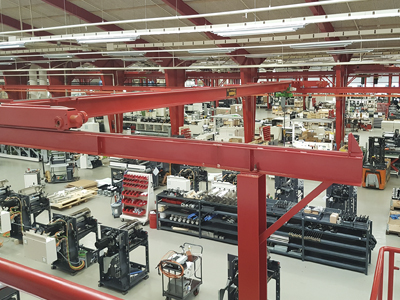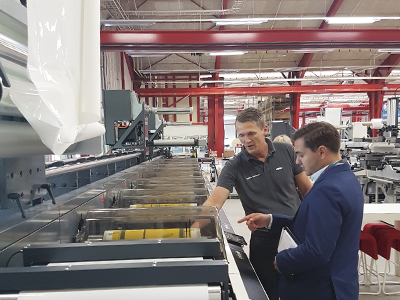FlexoTech editor, Michal Lodej, is shown around an All New FA press in the assembly line
Ready for Labelexpo, Danish press manufacturer Nilpeter, will launch its ‘All New’ FA narrow web flexo press. Michal Lodej went to the company’s manufacturing facility in Slagelse, just outside Copenhagen, to learn all about it.
There is nothing better than seeing a trade show full of new product releases, and Nilpeter will certainly not disappoint by introducing its all new FA press at Brussels this September.
The ‘All New’ FA press will complement the FA* which has been the company’s top of the range press since 2012. Anne Emborg, marketing manager, said, ‘Essentially we have enhanced the press that operators know and love but it will have some brand new features, tooling and software – with a strong focus on Clean-Hand Technology eliminating manual interfaces.’
The new press is configured to be flexible and its configurations can come in many different ways, film packaging or carton packaging modules can be added depending on what the customer requires.
Mrs Emborg added, ‘The label market has been around forever and it is still growing, but the new kinds of products available today is also growing as label printers move more and more into packaging. The modules available on the all new FA allow you to print all different types of labels and flexible packaging. With this modular approach you can add these different capabilities when you need them.’
The press has been designed to be intuitive to operators, and can be run from an iPad, which can be fastened to the press on a runner, allowing the operator to slide it along with them to any part of the press.
The iPad is not just a flashy gimmick but an attempt to solve a problem the industry faces on a global scale; trying to find new young printers.
Mrs Emborg explained, ‘If you want more printers then you have to find them young and then train them up yourself. We as a manufacturer need printers too, and they are hard to find. If you give someone an iPad it is very intuitive and they can understand it. They appeal to the younger generation who don’t want jobs where they get their hands dirty.’
The iPad control, is a huge part of the company’s Clean-Hands system and includes the function to open all the print stations at just the tap of a screen.
Winning formula
The company’s factory in Slagelse is a top of the range manufacturing facility, with a clear workflow and structure for a slim line production. Now the company is introducing this style in all its factories across the globe, which is requiring some major investments in its manufacturing facilities.

A view of the Nilpeter assembly line
At the moment the company is transforming its US factory, which currently produces its range of FB presses, so that it is instead equipped to build the new FA press. In fact Nilpeter USA will be the first site to have the all new FA in its Technology Center.
In it’s Indian facility the company will be making a new version of the FB press which again will have a number of value added units available.
The factory in India will also have a technical centre there as that is a corner stone for Nilpeter’s customer service policy.
Mrs Emborg explained, ‘We believe its right to have a place for customers to come with their problems and help them to work it out. This tech centre will feature the FB for people to see and use.’ Other Nilpeter technical centres can be found in Cincinnati and Bangkok to help the company’s global reach.
In the centre
Just like the sites around the world, the technical centre in Slagelse is a space for customers to test machines and also try to solve problems they may have with complex jobs. At the time of visiting the technical centre Housed the FA*, MO Line, and the Panorama hybrid press.
The FA* in the tech centre was being dismantled, after being sold to an overseas customer which had suffered a factory fire and needed new equipment desperately. The next time a flexo press goes into the centre it will be the new FA.
Typically the company shows customers three different jobs on the press so they can see what a real changeover will look like.
This particular press comes with a special unit for tube laminates a FP4 Unit for hot foiling and a cross over unit for peal and reveal labels and multi-page labels.
The Quick-Change Die unit which allows operators to change die cutters on the fly was also in use. The whole idea for the machine is to enable quick changeovers. The Cold Foil unit also offers a money and waste saving feature for label designs which only require a small area of foiling that makes it is possible to use rolls of metallics as small narrow as 2cm.
The Panorama has also been updated to become one fully hybrid press with everything inline, as opposed to just being a flexo press with a inkjets stuck on top. The Panorama inkjet system runs with five colours, (CMYK+W), however the updated version will be able to run with low migration inks and will have an orange colour station too.
Every colour has three printing heads which every 10 minutes while dormant, shoots out ink, as part of its cleaning cycle to keep the nozzles clear.
Steel yourselves
The company makes all of its presses entirely from scratch; as an example the printing unit for the new FA is one single welded and spray-coated piece of steel – that is transformed to a highly accurate machine part in one process in the company’s sophisticated manufacturing system. It is a 24/7 machine shop, with automated processes to allow the operators to program some machines to work through
the night.
Mrs Emborg explained, ‘Every press is made to order and we don’t make many plain presses, they are all bespoke to the customer. The technical department often gets first time requests and will always find a way to make it for the customer. ‘
The company uses an automated stock management system takes parts to the mill and to be drilled with the holes it needs before being placed on the assembly line. It is not a completely humanless enterprise however, the company requires highly skilled engineers to check the machines are doing what they are supposed to, with some engineers having been trained up from when they were apprentices.
The big machines which drill and mill the large bits of steel are manufactured by Okuma. These milling machines are completely automated picking the tools they need and changing drill bits without any human interaction. After drilling the machine stands to cool and the measurements randomly with laser sensors that make sure everything is accurate.
The assembly line has been streamlined with investment in a Kardex system to improve manufacturing efficiency. The Kardex system saves a lot of space and helps the builders control stock levels and monitors levels of the inventory, it also automatically sends a purchase order when stock levels get to a certain level.
Once the presses have been finished and gone through Nilpeter’s intense quality control are then dissembled and shipped out in different parts and then reassembled onsite at the customer’s factory, where they go through a similar QC test and then signed off by the customer. This well-proved process ensures highest satisfaction for customers around the world.
Read the full July/August issue of FlexoTech here. Subscribe to the magazine for free – register your details here.






